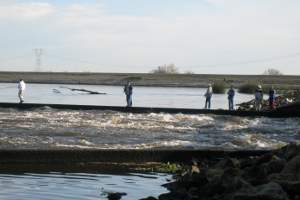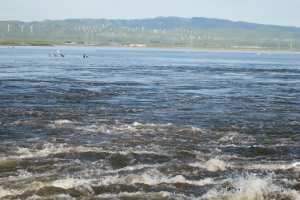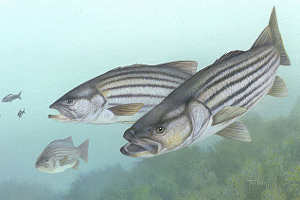Stripers are almost a naturalized citizen to the Delta, but farmers hope to blame the big fish for the plummeting numbers of endangered fish. If they win the case, which is now headed for trial, it could surely lessen the onus on water diversions from the Delta. That means the farmers could get more water, leaving the state to pay for costly mitigation measures to save the endangered fish species like Delta smelt and chinook salmon.
What is the evidence that stripers are wiping out these native species? At Clifton Court forebay, a large reservoir that feeds water to the pumps, stripers are a-plenty. Fishermen line the banks waiting for the gates to the forebay to rise so that the rushing water jostles the stripers out of their slumber. I met one fisherman down there who showed me a photo on his cellphone of a 15-incher he had recently caught. He brought it home for dinner.

It was also easy fishing for a team of state biologists who were on a motor boat in the forebay catching and tagging the stripers for further study. The big question the courts want answered is whether the stripers have a population level affect on the endangered fish species. Meaning, do stripers eat enough of these smaller fish to affect their numbers delta-wide. Here's where the science gets squishy.
In the lawsuit, the farmers and water users argue that stripers do have a population level effect.
They want to see fishing regulations on stripers lifted as a means to bring back endangered fish. But some biologists claim there's not enough research to show a population level impact. UC Davis fish biologist Peter Moyle says the best estimate done, involving a winter run chinook salmon, showed a 9 percent loss to stripers, which he says is “not a big number.” That was a National Marine Fisheries study. Remove the stripers, he says, and you could actually be upsetting a balance in the ecosystem. Stripers may be keeping other predators in check, like the tiny inland silverside, another non-native fish that has an appetite for delta smelt eggs.
Perhaps the best solution is to target striped bass fishing where we know they hang out – at places like Clifton Court Forebay and other structures created by the state and federal water projects. It's here where the endangered fish are most vulnerable, and where the stripers know they can find an easy meal.
 Listen to Delta Predators radio story online.
Listen to Delta Predators radio story online.
38.16047628099622 -121.47445678710938



